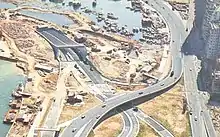| Kellett Island | |||||||||||||
|---|---|---|---|---|---|---|---|---|---|---|---|---|---|
| Traditional Chinese | 奇力島 | ||||||||||||
| Simplified Chinese | 奇力岛 | ||||||||||||
| |||||||||||||
| Tang Lung Chau | |||||||||||||
| Traditional Chinese | 燈籠洲 | ||||||||||||
| Simplified Chinese | 灯笼洲 | ||||||||||||
| Literal meaning | Lantern island | ||||||||||||
| |||||||||||||




Kellett Island is a former island of Victoria Harbour, off East Point in Hong Kong. It is now connected to Hong Kong Island at Causeway Bay following land reclamation in 1969.
It is located in Wan Chai District.[1]
Facilities

The main buildings of the Royal Hong Kong Yacht Club are located on the former Kellett Island. The former island and the reclaimed land form the western boundary of the Causeway Bay Typhoon Shelter. The southern entrance to the Cross-Harbour Tunnel is located on the Island.
History
The island was ceded to Britain together with Hong Kong Island. A small fort was built on it in 1841 for the protection of the eastern section of Victoria Harbour,[2] and a battery with three cannons was added in 1854.[3] The island was renamed in the 1860s (some sources mention 1842)[4] after the naval officer Sir Henry Kellett. Kellett Bay and Mount Kellett were also named after him.[5][6] After Kowloon Peninsula was ceded to Britain in 1860, the defense position of Kellett Island declined in importance, and it was used by British armed forces for ammunition and gunpowder storage.[4][3]
The island remained for the use of the Navy until 1938, when the Royal Hong Kong Yacht Club, formerly located in North Point, moved to Kellett Island. The clubhouse was built in 1939[3] on the foundations of the old Naval Powder Magazine.[7] The new premises were formally opened on 26 October 1940 by the then Acting Governor, Lieutenant General Sir E. F. Norton.[8]
After the fall of Hong Kong in 1941, occupying Japanese forces kept military supplies there, including fuel, gunpowder, artillery and ammunition.[9] After the War, the Yacht Club was reopened there on 17 September 1945.[7]
A causeway completed in 1952 was built to give access to the island by means other than water. Following reclamation work in the 1960s and the completion of the Cross-Harbour Tunnel in 1972, Kellett Island was connected to Causeway Bay and its original outline disappeared, although the name remained.[7]
In October 1991, a pottery jar containing large quantity of Chinese copper coins was discovered at the island by the Royal Hong Kong Yacht Club. The coins were dated to Sui, Tang and Song dynasties (589–1279). The coins and the pottery jar were then handed over by the club to the Antiquities and Monuments Office.[10][11]
References
- ↑ "District Council Constituency Boundaries — Wan Chai District" (PDF). Electoral Affairs Commission. Retrieved 21 March 2021.
- ↑ Eitel, Ernest John (1895). Europe in China: the history of Hongkong from the beginning to the year 1882. Luzac & Co. p. 181.
- 1 2 3 Brief Information on Proposed Grade 3 Items. Item #737 Archived 2012-10-17 at the Wayback Machine
- 1 2 Consultancy Agreement No. NEX/2213. Environmental Impact Assessment (EIA) Study for Shatin to Central Link - Hung Hom to Admiralty Section. Chapter 4: Cultural Heritage Archived 26 April 2012 at the Wayback Machine and Appendix 4.1 Cultural Heritage Baseline Report Archived 2013-10-24 at the Wayback Machine, pp.4-10, 78. MTR Corporation Limited
- ↑ Wordie, Jason (2002). Streets: Exploring Hong Kong Island. Hong Kong: Hong Kong University Press. p. 141. ISBN 962-209-563-1.
- ↑ Yanne, Andrew; Heller, Gillis (2009). Signs of a Colonial Era. Hong Kong University Press. p. 41. ISBN 978-962-209-944-9.
- 1 2 3 History of the Royal Hong Kong Yacht Club
- ↑ England, Vaudine (1998). The Quest of Noel Croucher: Hong Kong's Quiet Philanthropist. Hong Kong University Press. p. 130. ISBN 978-962-209-473-4.
- ↑ Captions to intelligence drawings from the collection of Colonel Lindsay Ride, held by the Australian War Museum, on loan to LCSD
- ↑ "The Geographical Information System on Hong Kong Heritage". Archived from the original on 12 November 2014. Retrieved 2 September 2006.
- ↑ Kellett Island Site of Archaeological Interest